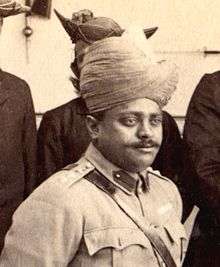Scindia School
| The Scindia School | |
|---|---|
| Location | |
|
The Fort Gwalior, Madhya Pradesh, 474008 India | |
| Information | |
| School type | Residential boys school |
| Motto | "Knowledge Liberates" |
| Religious affiliation(s) | secular |
| Founded | 1897 |
| Founder | Maharaja Madho Rao Scindia of Gwalior state |
| School board | CBSE |
| Principal | Dr. Madhav Deo Saraswat[1] |
| Gender | Male |
| Enrolment | 600[2] |
| Pupils | 600 |
| Student to teacher ratio | 1:10 |
| Classes offered | Class VI to Class XII |
| Medium of language | English |
| Classrooms | Modern Smart class rooms |
| Campus size | 110 acres (0.45 km2) |
| Colour(s) | Blue/White |
| Affiliation | CBSE |
| Website | www.scindia.edu |
The Scindia School is an Indian boarding school for boys, established in 1897, and situated in the historic Gwalior Fort, in the city of Gwalior. It was originally started exclusively for nobles and princes of Royal families, particularly the Marathas, though it no longer discriminates on class.[3][4] As of 2010, the school has enrolled 606 students, with a teacher:student ratio of 1:12. The school is noted for its advanced IT facilities.[5]
Scindia is a member of the Round Square Conference.
History

The Scindia School was founded by the late Maharaja Madho Rao Scindia of Gwalior in 1897, as the Sardar School. It was meant exclusively for sons of Indian princes and nobles. It was renamed The Scindia School in 1933, as it evolved into a public school with a Board of Governors, presently headed by Jyotiraditya Scindia, MP and the scion of Scindia family.[3][6]
It was in the city of Gwalior and was shifted to the Gwalior Fort around the turn of the century. The Scindia School eventually became a public residential school for boys under the headmastership of F G Pearce. The school celebrated its centenary in October 1997. Scindia School was ranked as the 3rd best boys boarding school in India 2014 according to the Education World Magazine.[7]
Student life
Situated at the heart of India, the school is set on the historic hill fortress of Gwalior, 300 ft (91 m) above the surrounding city.
The school has classes from grade 6th to 12th. It is believed to be the first school in India to be a member of an international organization, Round Square, a group of the most reputed schools in the world.
Facilities
The library is open seven days a week, 14 hours a day.
The school computer centre has a windows 2007 domain based network of Acer rack servers and Core-i5-based machines which run on a FTTH fibre optic backbone of 100Mbit/s. The centre has a wide variety of equipment, including Canon digital motion cameras, non-linear video editing system, iMac machines; as well as an extensive suite of media editing software. All class rooms are enabled with ICT resources with ultra short throw interactive projection systems.
A health centre takes care of student medical needs. A resident doctor, a nurse and a ward master take care of all student requirements. For complicated cases or emergencies the school calls upon its panel of specialists in the city and also avails of the facilities provided by nursing homes and unmatched facilities provided by the local Indian Air Force station.
The total strength of students is approximately 700.
Housing
The school is in the erstwhile barracks of British soldiers and the teachers live in the residential quarters once occupied by the British officials.
The school is divided into twelve houses, four for juniors and eight for seniors, each named after places and individuals from Maratha history. Junior houses are Jankoji, Dattaji (Sarvapalli), Nimaji and Kanerkhed (Siddharth). Senior houses are Jayaji, Ranoji, Mahadji, Jeevaji, Madhav, Shivaji, Daulat (Vivekanand) and Jayappa (Chaitanya) (Jyotiba house was discontinued in 2003).
The four houses for the junior boys are looked after by housemistresses, matrons and other domestic staff. The senior houses have a housemaster and a resident tutor along with the domestic staff. The housemaster's residence and that of another faculty member are attached to each house to ensure the availability of pastoral guidance.
Activities
Extracurricular activities are organised by senior students and supervised by faculty. The school has Junior and Senior Debating Society teams and two literary societies — one for English and one for Sanskrit and Hindi. The students run societies to cater to interests in history, geography, mathematics, science, and ICT. The School Council, composed of elected students teachers, give students a large degree of self-government.
Students take up hobbies like music, photography, painting, glass painting, batik dying, papier-mâché, clay modelling, pottery, stone carving, wood work and metal work. They are encouraged to learn first aid, automobile mechanics and to develop an interest in Information Technology. Students participate in educational camps, nature camps, adventure activities — outdoor survival, mountaineering expeditions, white water rafting, skiing and cycling being a few of many examples.
Sports
Students participate in sports including track & field athletics, soccer, hockey, cricket, basketball,skating,horse riding, archery, rifle shooting, boxing, equestrian, squash, tennis, badminton, swimming and deep-pool diving and more. A large multi-purpose gym serves the students in their indoor sporting pursuits.
See also
References
- ↑ Principal
- ↑ School at a Glance
- 1 2 "Education to excel: Scindia School in Gwalior is rated as one of the finest public schools for boys". The Tribune. May 23, 2004.
- ↑ Suparna Saraswati (May 13, 2001). "Where little minds imbibe the value of silence". The Tribune.
- ↑ "The Scindia School - ICT facility". The Scindia School. Retrieved 28 July 2012.
- ↑ "Caleidoscope:Boys from the fort school". The Telegraph. April 13, 2008.
- ↑ Rankings 2014
External links
| Wikimedia Commons has media related to Scindia School. |
Coordinates: 26°13′03″N 78°10′02″E / 26.2175°N 78.1672°E